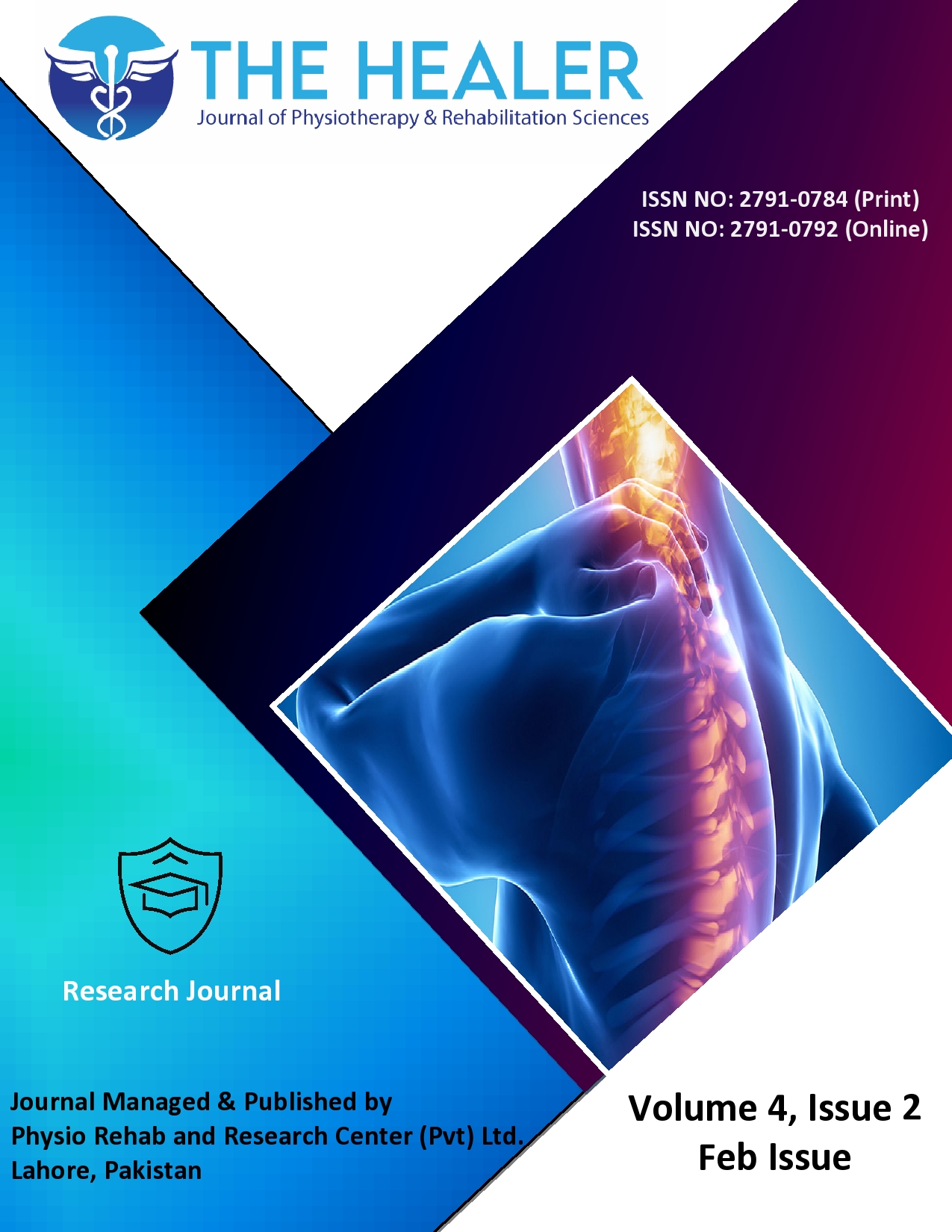Prevalence of Carpal Tunnel Syndrome in Pregnancy; A Cross-Sectional Study
Prevalence of Carpal Tunnel Syndrome in Pregnancy
DOI:
https://doi.org/10.55735/hjprs.v4i2.196Keywords:
carpal tunnel syndrome, pregnancy, prevalenceAbstract
Background: Carpal tunnel syndrome is the most common compression neuropathy of the median nerve, which can occur or aggravate during pregnancy and sometimes needs surgery. The most common cause of complaints in pregnant women is carpel tunnel syndrome. The investigation is meant to report the prevalence of carpal tunnel syndrome in connection to pregnancy and evaluate how huge the infection was among pregnant females. Objective: To assess the prevalence of carpal tunnel syndrome in pregnancy. Methods: The study was cross-sectional and data was collected from surgical and gynecological departments of four major hospitals of Lahore which are General Hospital Lahore, Nawaz Sharif Social Security Hospital Multan Chungi Lahore, Jinnah Hospital Lahore, and Children’s Hospital Lahore and was compiled at University Institute of Physical Therapy of the University of Lahore. The study was completed 6 months after the approval of the synopsis. The size of the sample is 256 and used convenient sampling technique. Pregnant women who had been under 20-40 years and excluded those who had high-risk pregnancies, psychological conditions, chronic medical illnesses like cancer, cardiovascular disease, etc. A cross-sectional survey was done on 256 subjects at different hospitals in Lahore using the Carpal Tunnel Syndrome Questionnaire for Wrist or hand pain to determine the prevalence rate of pregnancy-related carpal tunnel syndrome data and is analyzed through the SPSS 21 version. Results: During the study period, 256 pregnant women attending different hospitals and 118 (46.0%) women were found to have carpel tunnel symptoms. Most of them were in 3rd trimester of pregnancy 55.9%(143) followed by the 2nd trimester 21.9%(56) and the least was in the 1st trimester 22.3%(57). The most common complaint was numbness, particularly during the daytime (30.0%), while the least frequent symptom reported was pain. Conclusion: A large number of pregnant women suffer from the recurrent experience of carpal tunnel syndrome in pregnancy and it is first noted during the third trimester, but only in 50% of women symptoms vanish one year after delivery. Although pregnancy is typically viewed as a risk factor for this syndrome.
Downloads
References
Sapuan J, Yam KF, Noorman MF, et al. Carpal tunnel syndrome in pregnancy-you need to ask! Singapore Medical Journal 2012; 53(10): 671-5.
Zafar R. Level of Functional Impairment using Symptom Severity and Functional Status Scales in Patients with Carpal Tunnel Syndrome. The Healer Journal of Physiotherapy and Rehabilitation Sciences 2021; 1(2): 58-62.
Bahrami M, Rayegani S, Fereidouni M, Baghbani M. Prevalence and severity of carpal tunnel syndrome (CTS) during pregnancy. Electromyography and Clinical Neurophysiology 2005; 45(2): 123-5.
Ablove RH, Ablove TS. Prevalence of carpal tunnel syndrome in pregnant women. Wisconsin Medical Journal (WMJ) 2009; 108(4): 194.
Malakootian M, Soveizi M, Gholipour A, Oveisee M. Pathophysiology, diagnosis, treatment, and genetics of carpal tunnel syndrome: a review. Cellular and Molecular Neurobiology 2023; 43(5): 1817-31.
Li Z-M, Jordan DB. Carpal tunnel mechanics and its relevance to carpal tunnel syndrome. Human Movement Science 2023; 87: 103044.
Voitk AJ, Mueller JC, Farlinger DE, Johnston RU. Carpal tunnel syndrome in pregnancy. Canadian Medical Association Journal 1983; 128(3): 277.
Meems M. Carpal tunnel syndrome during pregnancy and the postpartum period and the effect of mechanical traction treatment. 2016.
Khosrawi S, Maghrouri R. The prevalence and severity of carpal tunnel syndrome during pregnancy. Advanced Biomedical Research 2012; 1.
Rasool J, Akram S, Jamil A, Tauseef M, Ilyas A. Effects of Power Ball Exercises in Addition to Routine Physical Therapy on Pain, Grip Strength and Functional Disability in Patients with Carpal Tunnel Syndrome: Power Ball Exercises in Carpal Tunnel Syndrome. The Healer Journal of Physiotherapy and Rehabilitation Sciences 2023; 3(4): 451-60.
Malahias MA, Johnson EO, Babis GC, Nikolaou VS. Single injection of platelet-rich plasma as a novel treatment of carpal tunnel syndrome. Neural Regeneration Research 2015; 10(11): 1856.
Padua L, Cuccagna C, Giovannini S, et al. Carpal tunnel syndrome: Updated evidence and new questions. The Lancet Neurology 2023.
Pratelli E, Pintucci M, Cultrera P, et al. Conservative treatment of carpal tunnel syndrome: Comparison between laser therapy and fascial manipulation â. Journal of Bodywork & Movement Therapies 2014; 20: 1e6.
Dahlin E, Zimmerman M, Björkman A, Thomsen NO, Andersson GS, Dahlin LB. Impact of smoking and preoperative electrophysiology on outcome after open carpal tunnel release. Journal of Plastic Surgery and Hand Surgery 2016: 1-7.
Finsen V, Zeitlmann H. Carpal tunnel syndrome during pregnancy. Scandinavian Journal of Plastic and Reconstructive Surgery and Hand Surgery 2006; 40(1): 41-5.

Downloads
Published
License
Copyright (c) 2023 The Healer Journal of Physiotherapy and Rehabilitation Sciences

This work is licensed under a Creative Commons Attribution 4.0 International License.














